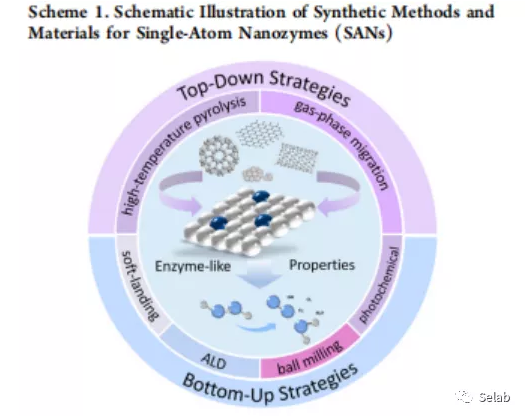
hotline:
17715390137
Tel/Wechat:
18101240246 (Technology)
0512-68565571
Email:mxenes@163.com (Sales Engineer)bkxc.bonnie@gmail.com
Scan the code to follow or search the official account on WeChat:
2D Materials Fronrier After paying attention,
click on the lower right corner to contact us,
Enter enterprise WeChat.
Professional Services Online

 Abstract: Single-atom nanoenzymes (SANs) are one of a new generation of nanoenzymes that have developed rapidly in recent years, and have a wide range of applications in biosensing, disease diagnosis and treatment, and bioimaging. SANs have a dispersed single-atom structure and a good coordination environment, with significant catalytic activity and stability. This article reviews the research progress of SANs at home and abroad in recent years from the aspects of synthesis, characterization, functional mechanism, performance verification/optimization, and biomedical applications. Several technical problems affecting the practical application of SANs are analyzed, and possible research directions to overcome these problems are proposed.
Abstract: Single-atom nanoenzymes (SANs) are one of a new generation of nanoenzymes that have developed rapidly in recent years, and have a wide range of applications in biosensing, disease diagnosis and treatment, and bioimaging. SANs have a dispersed single-atom structure and a good coordination environment, with significant catalytic activity and stability. This article reviews the research progress of SANs at home and abroad in recent years from the aspects of synthesis, characterization, functional mechanism, performance verification/optimization, and biomedical applications. Several technical problems affecting the practical application of SANs are analyzed, and possible research directions to overcome these problems are proposed.
The advantages of SANs and their synthesis strategy:
One of the main advantages of SANs is the unique structure of the active site, and the relationship between structure and activity can be studied by theoretical calculations. And the density of active sites of SANs can be adjusted by different synthetic strategies. In addition, due to its unique metal-like enzyme active center and clear coordination environment, it helps researchers rationally design highly efficient and selective nanoenzymes and further study its catalytic mechanism.
For homogeneous and heterogeneous catalysis, SANs have clear active centers. SACs are formed by the dispersion of single metal atoms on a suitable supporting surface. There are two main integrated strategies for designing SANs, bottom-up and top-down. The bottom-up method is mainly based on atomic layer deposition (ALD), high-energy ball milling, mass selective soft landing and photochemical strategies. The top-down method includes high temperature pyrolysis and gas phase migration. The preparation methods of SANs include high temperature pyrolysis, wet chemical strategy, atomic layer deposition and so on.
02

In the synthesis of SACs or SANs, the key to success is to choose a suitable support substrate to make the isolated metal atoms tightly bond to prevent their aggregation. This is because, during the catalysis process, a sharp increase in surface free energy and unstable thermodynamic properties can lead to agglomeration and then deactivation of well-dispersed individual atoms.

03
note
Supports for SANs are:
Carbon support: Carbon-supported SACs or SANs have been widely studied as catalysts due to their unique characteristics, such as adjustable morphology, ordered pores, and easy fixation by various metals (noble and non-noble metals). The three main SACs carbon-based materials are n-doped carbon, carbon nitride and mof-carbon.
Non-carbon support:
In addition to carbon-based nanomaterials as supporting substrates, transition metal oxide-based nanomaterials have also been explored for the manufacture of SANs for natural enzymes. The transition metal oxide support can affect the catalytic performance of the atom-dispersed metal through the interaction of the metal support. This is because the electronic properties of the transition metal oxide support change the activity and selectivity of SANs. In addition, the different structures and compositions of the supporting substrate also determine the various forms of atomic dispersion.
Application of SANs: Due to the coordination of unsaturated active metal centers similar to metal enzymes, SANs have successfully simulated peroxidase, superoxide dismutase, catalase and oxidase, and are used in biosensing, antibacterial applications, Used for cell protection.
Original link
DOI: https://pubs.acs.org/doi/abs/10.1021/acs.analchem.0c04679
https://pubs.acs.org/doi/abs/10.1021/acs.analchem.0c04679
https://pubs.acs.org/doi/abs/10.1021/acs.analchem.0c03366

| Reminder: Beijing Beike New Material Technology Co., Ltd. supplies products only for scientific research, not for humans |
| All rights reserved © 2019 beijing beike new material Technology Co., Ltd 京ICP备16054715-2号 |